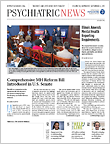Treatments for medical conditions have continued to evolve and change since we learned how to treat patients in medical school and residency. Some of the changes have been dramatic, such as new treatments for HIV, targeted cancer therapies, and the use of laparoscopic surgery. Psychiatric modalities have also changed. In the last decade, studies have been reported of new types of psychosocial therapies, new medications, and new thinking about how to use established medications, for example, the use of atypical antipsychotics or mood-stabilizing agents in various conditions.
To whom should other health care and mental health professionals turn to learn about how to practice in the best possible manner incorporating new studies and data? As psychiatrists, we are the experts in mental health and mental illness. I chose “Claiming Our Future” as the theme for my presidential year. This includes claiming our role in the development of updated treatment guidelines and protocols for the use of somatic treatments and psychosocial treatments, including psychotherapy, for patients who suffer from psychiatric conditions. We want to improve quality of care and give guidance on the current thinking for difficult treatment dilemmas.
In March 2011, the Institute of Medicine (IOM) issued a report calling for higher standards in developing clinical practice guidelines. The IOM called for transparency, improved management of conflicts of interest, and a rigorous review of the scientific evidence including the quality, quantity, and consistency of the evidence. The IOM report also called for external review by relevant stakeholders including scientific and clinical experts, organizations, patients, and representatives of the public, among other recommendations. APA answered that call, and later that year our Steering Committee on Practice Guidelines developed and reported to the Board of Trustees on the process that would align with the IOM standards.
Key features of the process include (1) addressing a defined set of clinical questions on the topic that are identified as having the potential to improve quality of care, (2) conducting a systematic review of the available evidence, (3) evaluating the strength of available evidence using a formal grading method, (4) assessing expert opinion by a formal survey, and (5) developing recommendations based on the balance of benefits and harms for each statement.
Although APA has previously published a series of practice guidelines, the first guideline developed with this new process is now available:
The APA Practice Guidelines for the Psychiatric Evaluation of Adults, Third Edition. Because of the desire to educate and lead all mental health practitioners in best practices, the guidelines are available for free download at the American Psychiatric Association Publishing
website. We are also working on developing educational materials for different member constituencies based on these guidelines.
The second practice guideline using this rigorous process is now in development. This guideline addresses a difficult clinical dilemma. What is the best treatment for agitation and psychosis in patients with dementia? What is the appropriate management? A black-box warning on atypical antipsychotics says that there is an increased risk of death if these drugs are used for elderly patients with dementia-related psychosis. However, how does this translate into practice? If a patient with dementia becomes agitated, what should be done? The use of restraints is generally contraindicated. Who is the definitive source of information for the practicing clinician? It needs to be APA.
Over the last six to eight months, a group of experts was convened by APA who reviewed the literature and also relied on their clinical experience. Studies were reviewed for whether they were definitive or suggestive. Following this exhaustive process, the draft of the new guideline was recently released for review by all APA members, outside allied organizations, and experts. I encourage you to review this guideline and provide feedback. The draft guideline is posted
here. All comments are due by September 19 and will be reviewed and assessed by our writing group. When completed, our Assembly and the Board will vote on its approval, and in the end, the APA guideline will be the definitive source of information on the use of antipsychotics to treat patients with dementia for agitation and psychosis.
The work under these higher standards is only beginning. A guideline on treatment for bipolar disorder is in its very early stages. APA members are encouraged to
submit topics for review.
If we don’t take on this mission, who will? Insurance companies? Oversight bodies such as accreditation agencies for nursing homes? If we allow someone else to take the mantle of mental health medical leadership, our patients and their families will lose. The mission of developing treatment guidelines is part of psychiatrists’ claiming our future as the leaders of determining what constitutes excellence for our patients. ■

